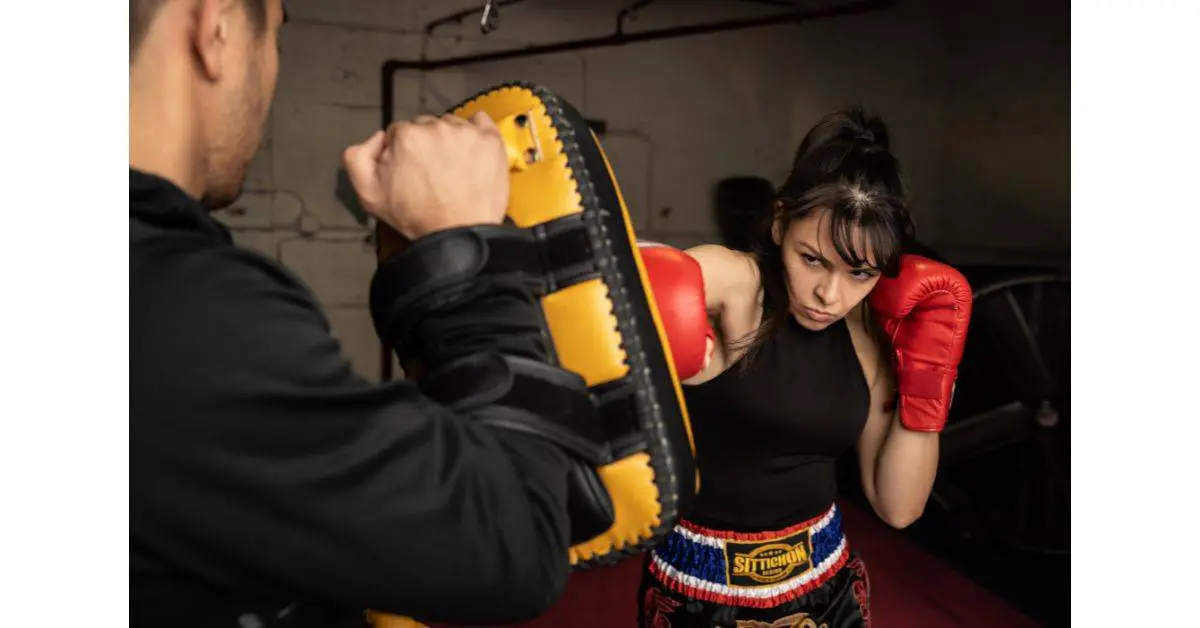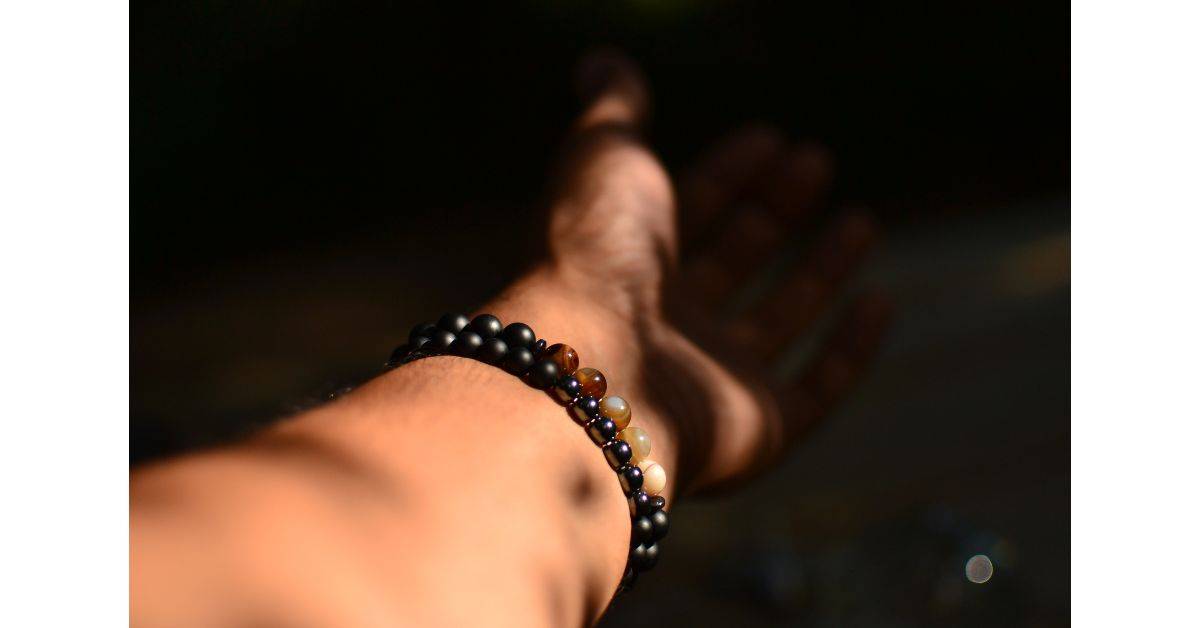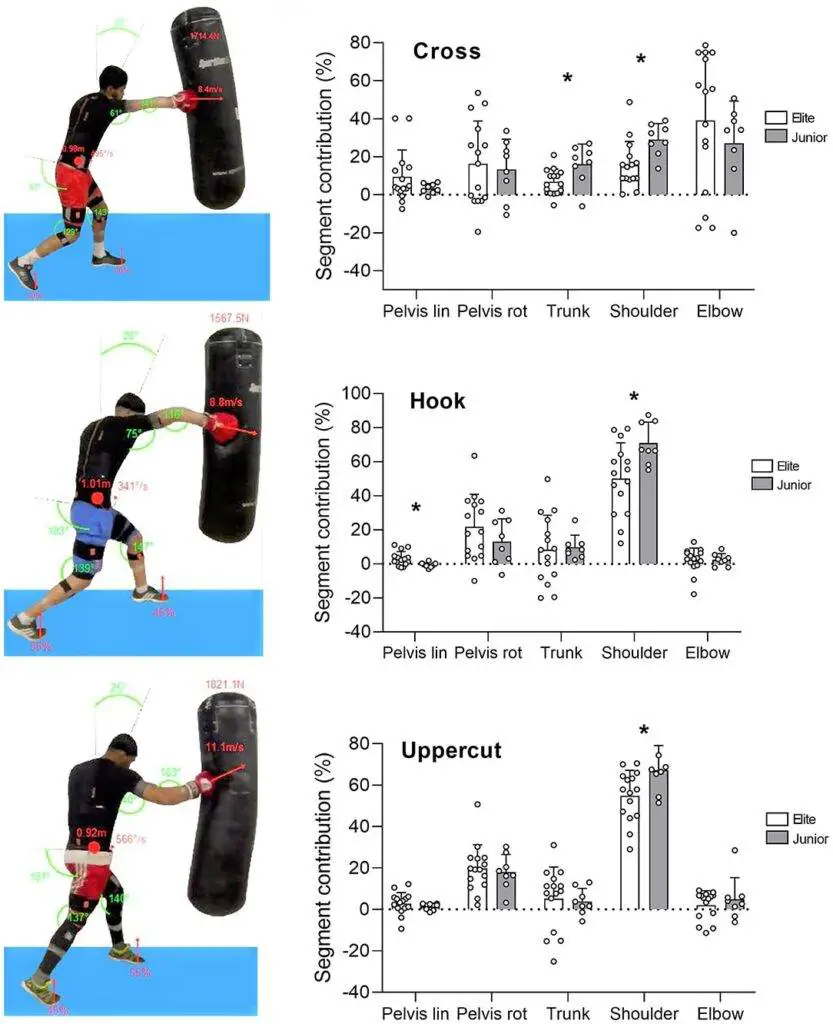Having bigger and stronger forearms are a highly desirable trait. Some boxers believe they can increase their grip strength and thus punch harder. However, such a claim isn’t accurate. You can’t increase force significantly by building a relatively low-contribution muscle to your punching force.
Forearms won’t make you punch harder because most of your punching force comes from the hamstrings, quads, shoulders, and arms. However, having a better grip strength equals punching harder without hurting yourself. Nonetheless, working on your boxing technique is the best way to increase punching power.
Don’t get me wrong; I’m not suggesting you skip your wrist workout. Having robust forearms and better grip strength will allow you to perform more movements and hold more weight. Likewise, it’ll help you make a stronger fist, making you less prone to injuries.
But the force you generate doesn’t necessarily come from your strength. That’s why many skinny boxers can dominate their competition, even if they are more muscular.
Instead, it’ll be best to hone your boxing technique if you want to increase your punching power. Indeed, the driving force of your punching power is your legs. So, make sure not to skip leg day too.
Before we dive into the article – if you want to learn how to hit first in a fight, follow the link.
Do big forearms make you punch harder?
Imagine punching someone with your full force with open hands. You’ll probably break your knuckles and joints around the hand. That’s because your forearm and knuckles didn’t suffer the resistance suitably. That’s why a more muscular grip strength and forearms will help you punch harder.
While strong forearms won’t necessarily mean you can generate more force with your punches, as the driving force of your punches are the legs, hips, and shoulders, you’ll be capable of punching harder and not hurting yourself. Likewise, strong forearms will allow you to hit harder and not hurt yourself.
I want to add something: strong forearms aren’t necessarily big. Your size and strength don’t correlate linearly. That’s why you might see someone with skinny muscles having incredible grip strength.
The best way to increase your punching power will be to work on your boxing technique. Don’t get me wrong; your grip strength may affect your punching power slightly. However, it’ll be best to focus on your boxing technique and not on working your forearms.
The forearm’s role is to be a link to the force from your legs, shoulders, and all other driving muscles to the opponent. That’s why it’ll help you, if it’s strong, to withstand more force and resistance.
However, your forearm strength won’t necessarily link to your punching power.
How to improve forearm strength for punching
Having more muscular forearms means being able to punch harder easily. Likewise, having better grip strength directly correlates to more powerful punches. But we’ll expand on this topic in the next section of this article. So now, let’s see how you can effectively improve your forearm, wrist, and grip strength.
Hand grips are the most effective way to improve forearm, wrist, and grip strength. These are designed to give you a thorough, specific workout. Likewise, you can also focus on compound movements in weightlifting, such as the deadlift, bench press, and even squats. These will help as well.
According to a study that examined improving forearm strength through two training routines, “These data indicate that a 12-week stepwise periodized training program can significantly increase wrist, forearm, PS, and BP strength for both groups.”
You might ask yourself what they did to increase wrist and forearm strength. Group 1 explicitly trained on compound movements, such as the bench press. However, group 2 also performed various wrist and forearm exercises. That’s to check whether specific forearm exercises are necessary to increase its strength.
Eventually, both groups significantly increased their wrist and grip strength. That means you can either focus on lifting weights or forearm exercises, such as wrist barbell extension. Both will give you results.
Best wrist and forearm exercises for more punching power
This section will focus on exercises you can perform that will directly impact punching power. However, the best way to increase your punching force will be to attend a boxing gym more often.
Let’s dive into the different exercises.
Rice bucket
The first exercise is the rice bucket. It’ll require you to get about 15 pounds of rice and put it in a 5-gallon bucket.
Then, you dip your hand inside and perform motions to train your wrist and forearm. Many professional boxers use this exercise to condition and strengthen their grip and forearms.
I wrote an entire article on how to use the rice bucket, so follow the link to learn more.
Hand grips
The second exercise is using hand grips. I believe it’s the best way to train your forearms and grip strength, as it’s effective, and you can do it anywhere you want.
You can sit in the passenger sit in a car and train your forearms. It really is that easy.
Here are the best hand grips you should buy to start training your forearms.
Deadlift
Deadlifting is the third way to increase your punching power. The deadlift is a compound movement that trains many muscle groups in your body.
Thus, it’s also a suitable exercise both for gaining muscle and burning more calories. So, it’ll be best if you deadlift, regardless of your specific fitness goal.
You perform the deadlift by lifting a barbell from the ground while using your back and legs. You typically load more weight on the bar when deadlifting. As a result, your forearms will work extra hours, as they have to hold more weight, which will strengthen them even further.
Boxing
The 4th exercise is, you guessed it, boxing. As we’ll see in the following section of this article, a solid way of increasing your grip strength will be to use it more often.
Your muscles will naturally adapt to the exercise you’re performing often. As such, sport climbers’ grip strength is higher than those who don’t climb.
Now, the first reason for that is that sports climbers have more forearm muscle. Nevertheless, another reason for that is that the climbers’ bodies neurally adapted to this activity. So, your forearm and wrist will strengthen the more you box.
Wrist curls
The last exercise of this section is the wrist curls. It can be a solid way of improving your forearms, and, thus, your punching power, as it’s easily accessible.
Getting your hands on a few dumbbells is easier than attaining a barbell with plenty of weight. The wrist curls can be a solid addition to your workout if you’re already lifting weights in the gym.
Try it out for yourself!
Grip strength and its effect on punching power
Boxing is a sport that requires you to use your grip constantly. Likewise, your wrist and hand will experience much resistance from all the punches you throw. That’s why you must train these parts separately, although most people skip training them.
While grip strength won’t necessarily increase your punching power directly, it will affect the force your hand can experience. The more grip strength you have, the more you’ll close your fist; thus, the less likely you’ll be to injure your hand. However, it won’t impact your punching force directly.
The best way to increase your punching power will be to hone your boxing technique. Focus on learning to shift your weight correctly and use your legs and hips more than you do your arm.
According to a study: “in experienced boxers, the legs contributed 38.6% of total punching force compared with 32.2% for the intermediate and 16.5% for the novice boxers.”
As you can see, you can use your legs to drive up to 40% of your total punching force. This number should be enough to trigger you into training your legs more often. Your legs’ strength and muscularity do have a direct impact on your punching force.
Follow the link if you want to learn how to strengthen your legs for boxing.
Why do boxers have big forearms?
A part of increasing your muscle in any area is to use it often. For example, boxing is a sport that requires you to make fists and flex your forearm often. So, boxing correlates with using your grip often. Now that we understand that – let’s see why it strengthens your forearms.
Boxers have big and strong forearms because they use them often in training. As a result, they’ll cause micro tears in the muscle fibers, eventually leading to hypertrophy (the muscle-building process in the body.) A part of increasing your muscles’ size is using them often. Boxing does just that with your forearms.

You can, if you want, incorporate specific wrist and grip exercises to work on them alone. However, it’s not necessary unless your grip strength is meager.
Instead, you’ll find that your grip strength has significantly increased if you focus on boxing training. Yes, that’s all you need to do.
Let me give you another example. I started boulder climbing 4 months ago. I couldn’t hold onto almost anything when I started, as my grip strength was low. After 4 months of boulder climbing, I can hold myself with my fingers.
I’ve not trained my grip strength, wrist, or forearms specifically. Instead, all I did was participate in the sport. As a result, my forearms grew significantly without training them specifically. And you can do that as well if you box often.
The findings suggest that the greater Maximal volitional contraction seen in boulderers and sport climbers may be a result of neural adaptations, not muscular hypertrophy.
SOURCE
This study assesses my point; boulderers and sport climbers have neurally adapted to the sport. As such, their grip strength is much higher than people who don’t climb, as they’re not using these muscles often.
Does more muscle equal more punching power?
You’re probably familiar with the basic physics equation, Newton’s second law, force equals mass times acceleration. (F= m*a) We can understand how punching force works according to this equation. To simplify things, you have two ways of increasing your force: mass or acceleration.
More muscle equals more punching force because you’ll have more mass and thus, more force. However, strength doesn’t directly correlate to punching force. According to newton’s second law, power equals mass times acceleration. So, if you increase your mass, your force will also directly increase.
Eventually, however, the best way to increase your punching force is by improving your boxing technique, and as such, attending an actual boxing gym will be the best way to increase your punching force in the long term.
Follow the link if you want to know how you can increase your punching power through various exercises.
Final words
Training your forearms will increase your punching power. However, it’ll be best to increase the force your hand can handle without it getting damaged.
As a result, all boxers who want to ensure their long-term health – must ensure their forearms and grip strength are solid.
You can either keep training in boxing for an extended period or specifically train your forearms. You can even combine both ways to ensure you strengthen them.
You’ll also enjoy reading a complete beginner’s boxing guide if you enjoyed reading this article.


